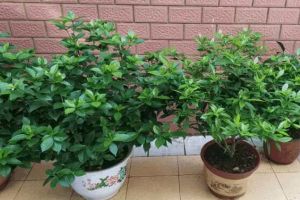The flowers you threw away were cut down by me, sprouting crazily, green for a month!

The dying rich tree comes back to life again and again.
The rich tree is the most common flower in the trash can. Its root system is weak and prone to water and rot. When it is thrown away, it is rotting and has no leaves. Despite the fact that it doesn't have any vitality, cut a few knives like me to make sure you live!
1. Almost all the rich trees die because of their rotten roots, so it is urgent to pick up the trunk of the rich tree and deal with its rotten roots.
two。 Put the roots under the faucet, rinse the soil, and prepare a lot of carbendazim, machetes (saws) and rooting agents.
3. With a sharp machete or saw, cut off the rotten roots completely, leaving no rot until the roots are fresh and clean as shown in the image below.
4. Soak the bottom trunk of the rich tree in carbendazim solution for about 10-15 minutes. After soaking, take it out, dry it and soak it in the rooting agent solution for 20-30 minutes.
Flower friends without rooting agents can get some willow branches to soak in water and act as rooting agents.
5. Use scissors to cut off the branches at the top of the rich tree, the shorter the better, because now the rich tree has no roots, leaving branches and leaves will only consume the nutrients of the trunk, which is not conducive to rooting.
After pruning, leave it in a cool and ventilated place to dry for 1-2 days.
6. After drying, the rich tree can be ready to be put on the basin. When it comes to the basin, the bottom of the basin is covered with ceramsite or cinder. The soil can be mixed with rotten leaf soil and sand to spray and make it slightly moist.
In addition, do not choose a basin that is too deep, like the one shown below is too deep, and if you have conditions, you can choose a shallow basin.
7. After the rich trees are planted, move to a cool and ventilated place without watering. For about 10 days, pour rooting powder into the soil.
8. After half a month or so, the rich tree will take root. During this period, you must not pour too much water. You can usually spray water around the tree trunk. After taking root, the rich tree will slowly grow small buds!
The dying green turnip cut a few knives, and several pots burst after a month!
It is not easy to raise a few years of green pineapple, as a result accidentally rotten roots, watching the original vibrant vines become withered and wilted, is it really hopeless? No, no! It can still be saved!
1. Pick out all the relatively healthy and sturdy vines of the green pineapple and cut them every 2 nodes with scissors.
two。 Prepare loose and breathable soil, those with coconut bricks at home can use coconut bricks, those without coconut bricks, you can mix rotten leaf soil, peat soil and perlite at 2:2:1, spray them and pour them into the flowerpot.
3. Spread the green rattan strips on the basin soil and sprinkle it with a thin layer of soil.
4. Spray water into the basin with a spray can with a thin nozzle. after spraying, cover a plastic bag or cover with a thin film to moisturize.
5. In this season, every morning, middle and evening, open the plastic bag to breathe for 1 hour, 7-10 days or so, the rattan will take root! If you accept some scattered light properly after growing roots, you will soon be able to grow small buds!
6. After the green pineapple grows small buds, apply compound fertilizer and water once every half month, and the pot will burst soon!
The root of the gentleman orchid is rotten, cut 2 knives and give birth to a big white root!
After summer, there must be a lot of gentleman orchids because of the dormant period, there are rotten roots, rotten stems and other problems, at this time, we do not immediately throw it away. Because even if its roots are rotten, it can still be fed with the following methods!
1. Use a sharp beauty knife to cut off the rotting roots of Cymbidium, including the rotting bulbs, all clean, otherwise there is a risk of rotting again.
two。 After cleaning the bulb of Cymbidium, put it in potassium permanganate solution and soak it for about half an hour. The ratio of potassium permanganate to clear water is 1Rom 2000. Carbendazim without potassium permanganate is fine at home.
3. After sterilization, take out the orchid and put it in a ventilated place to dry.
4. Prepare clean river sand, wet it, insert the magnolia bulb into the river sand, and the river sand can also be replaced by vermiculite, water moss or sawdust.
5. After planting, put the pot in a cool place, and the soil is dry and watered thoroughly. In about 15 days, the magnolia can produce a number of white and fat roots!
6. After the gentleman orchid grows root, can transplant to loose and breathable basin soil, normal maintenance, just transplant do not bask in the sun, put in a cool place, wait for 2 weeks to adapt, and then gradually bask in the sun, watering.
Yellow leaves withered gardenia, can save life!
Spring and summer season, people buy home gardenia, is it still alive? I believe there must be some flower friends of gardenia, yellow leaves, fallen leaves, wilting, dying. So how do you save it?
First, save the slightly withered and wilting gardenia
1. Put the withered and wilting gardenia in a ventilated place, spray a can with a thin mouth and slowly wet the soil surface.
two。 Cut off the withered and wilted branches and leaves, and don't cut the wilted and drooping leaves a little bit. these leaves, after absorbing water, will slowly recover!
3. Put the gardenia in a cool place, wait for the leaves to recover slowly, then pour water again, and then pour water to the bottom tray in the process of normal maintenance to ensure that the tray is not short of water.
Second, save Gardenia jasminoides with healthy roots but serious withered branches and leaves.
1. Move the severely withered gardenia to a cool and ventilated place and water it once.
two。 The seriously withered branches of gardenia should be cut off and re-cut with sharp scissors, leaving only about 8 centimeters of the main branch.
3. After cutting, put it in a cool place first, and then pour water thoroughly after the pot soil turns white. It will sprout in less than half a month, and after germination, you can bask in the sun!
Black rot longevity flowers, a month into a big pot!
Summer longevity flowers, the roots are extremely easy to black rot, if you find your longevity, black roots, we should take decisive measures, immediately cut, open and aboveboard!
1. Use sharp scissors to cut off the healthy branches of longevity flowers and require that there is no blackening in the cross section of the branches.
two。 Cut the branches of longevity flowers into several small segments, each of which is about 5-10 centimeters. After cutting, dry the incision in a light and ventilated place.
3. The rotten leaf soil and perlite are prepared according to the proportion of 3:1. If there is no rotten leaf soil and perlite at home, you can also use garden soil and river sand instead. Stir the soil evenly, spray it wet, and pour it into the flowerpot.
4. Put the dried longevity flower branches into the soil and put them in a cool and ventilated place for about 1-2 weeks to take root!
5. After taking root, pour water through the water, gradually bask in the sun, and soon the saved longevity flowers will be full of pots!
The withered crab claw orchid is thrown into the water and comes back to life immediately!
Crab claw orchid, after a summer dormancy, may root rot, leaf wilting, do not worry to throw it into the trash can, first throw water to try, will soon be alive, instantly green!
1. Buckle the crab claw orchid pot upside down and remove the root system to see if the root system is rotting.
two。 If the root system is rotting, don't be soft, click with clean scissors, cut it off thoroughly, and cut it clean!
3. After cutting the rotten roots and stems, you can put the healthy crab claw orchid branches in a cool and ventilated place to dry the wound. About 3-5 hours.
4. Prepare a hydroponic bottle or plastic bottle, pour into the water, insert the crab claw orchid into the mouth of the bottle, the bottom is about 0.5-1 cm from the water.
5. Without half a month, the crab claw orchid will slowly grow roots, and when the root system reaches about 3 cm in length, it can be transplanted into the soil!
6. When transplanting crab claw orchid, it is best to use breathable pine needle soil and put some chicken manure on the bottom of the basin. First astigmatism maintenance, after half a month, and then bask in the sun, watering 1-2 weeks or so once.
Compound fertilizer and water were applied every 2 weeks, and potassium dihydrogen phosphate was sprayed every 2 weeks before flowering.
- Prev

These 10 kinds of orchids have been seen by 800 million Chinese people, not to mention that you don't know how to raise them!
I remember that the first time Huahua raised flowers was a Phnom Penh orchid, which was resistant to shade and drought. Rest assured that if you raise it boldly, you can give birth to a bunch of small orchids. Today, Huahua is going to pull out the usual hanging orchids and have a look, and see if you can raise them in the end!
- Next

Gardenia drink some fairy water, immediately green straight oil, rub crazy growth can not stop!
Recently, the flowering period of Gardenia jasminoides is almost over, and many flower friends think that it is good to watch the leaves. Who would have thought that the gardenia leaves at home began to turn yellow! What on earth is going on? Today Huahua is here to reveal the reasons for the yellow leaves of gardenia!
Related
- What if the leaves of potted flowers turn yellow?
- Florescence Control of several Flowers
- Anti-freezing technology and post-freezing nursing technology of flowers
- What is the classification of flowers? What are the common methods of flower classification?
- Prevention and control of alkali and acid damage of flowers in courtyard
- Technology of Anti-freezing and restoring growth of Flower seedlings in greenhouse and greenhouse
- How does flower fertilization not hurt the root? Fertilization technology of flowers
- Key points of disinfection in flower greenhouse
- Several pesticides that are banned or used cautiously in flowers
- How to fertilize the flowers that watch the leaves?

